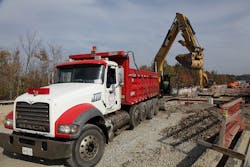Federal aim: maintain and improve efficiency in transportation
Speeches this week by Anthony Foxx, U.S. Transportation Secretary, and Rep. Bill Shuster (R-PA), Chairman of the House Transportation and Infrastructure Committee, at the annual “Washington Outlook” meeting organized by the American Association of State Highway and Transportation Officials, highlighted a new strategy focus by both President Obama’s administration and Congress on ways to make the U.S. transportation system more robust and efficient in the years ahead.
“The reality is many of our competitors are investing in deeper levels [of transportation spending] than we are,” noted Foxx. “China is spending twice as much related to their GDP [gross domestic product] as we are. If that continues year after year, we will find ourselves at disadvantage.”
He also stressed that U.S. transportation infrastructure system is deteriorating; a trend illustrated by the Deaprtment of Transportation's recent 2013 Status of the Nation's Highways, Bridges and Transit report and one that he said must be reversed quickly.
“We’ve slipped 20 places in infrastructure according to World Economic Forum to just behind Barbados; a country with one airport,” Foxx noted. “The political solution to this is really local; state by state, community by community: We need your help describing in real terms what this issue means to members of Congress so this issue is not an abstraction and is not easy to dismiss.”
Chairman Shuster echoed Foxx’s comments in his presentation, highlighting an observation by President Eisenhower that without the unifying force of transportation, The U.S. would be a mere collection of parts.
“Our transportation system physically connects us; we need to keep efficient and vibrant,” Shuster noted.
“Transportation is a quality of life issue for our citizens; it’s how we get to work, take our children to school, and go on vacation,” he added. “But more importantly it’s about business; it’s about building a strong ‘spine’ for the economy. The transportation system is critical to getting raw materials to the factory floor and for taking finished goods out into the marketplace, whether world markets or local grocery store.”
Both Foxx and Shuster also stressed, however, that more efficiencies need to be developed within the transportation system, from reducing the time needed to approve projects as well as continuing to find ways to lower the cost of infrastructure construction as well.
“We’re doing more to squeeze more out of every transportation dollar,” Foxx pointed out. “Take warm mix asphalt – what my staff knows as my favorite subject. It requires less heat but gets you comparable strength and using it will save $3.5 billion by 2020.”
He said it’s this “kind of thinking” that needs to be added to the transportation infrastructure funding equation, noting McKinsey & Co. study found that the world could gain the same level of transport infrastructure capability for 40% less. “We need to tackle our transportation infrastructure needs by addressing revenue challenges, but also by addressing our ability to be efficient,” Foxx pointed out.
Chairman Shuster emphasized the same point as well, noting in particular that there needs to be reform on how transportation projects get approved. “It just takes too darn long; 15 years in some cases,” he said. “And we still need to be fiscally responsible, too.”
But Shuster added that transportation infrastructure investments remain a critical tool to keeping the U.S. competitive in global trade.
“For example, some farmers in my district came to visit me recently – soybean producers,” he related. “They told me it costs $85 to move a ton of soybeans from here to China, while it takes the Brazilians – our major competitors – $141 to move that same ton to China, because they don’t have an inland waterway system like we do.”
However, several years ago, he said not only did Brazil announce it was going to invest substantially in connecting its waterways to improve transportation, but that China would help with that investment as well.
“So while we sit here and argue over transportation investments, we’re losing that competitive advantage year after year to our competitors,” Shuster stressed. “This is not just about soybeans – it’s about everything we move.”
About the Author
Sean Kilcarr
Editor in Chief
Sean Kilcarr is a former longtime FleetOwner senior editor who wrote for the publication from 2000 to 2018. He served as editor-in-chief from 2017 to 2018.
